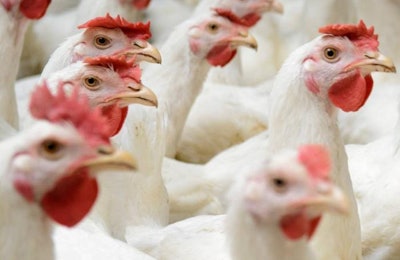
Are Sanderson Farms – and other U.S. chicken producers – poised for a big jump in earnings in 2017?
While Sanderson Farms executives stopped short of making any earnings prediction at the Stephens Spring 2016 Investor Conference, their outlook had at least one analyst envisioning strong profitability in the year ahead.
Stephens Managing Director Farha Aslam, after listening to the Sanderson Farms presentation, said, “My earning per share estimate [for Sanderson Farms] for fiscal 2017 is between $4 and $5 above consensus. What do you think about my number?”
Modeling robust earnings is not unreasonable
The obligatory demurral came from Sanderson Farms Chief Financial Officer Mike Cockrell, “We don’t comment on models.” He offered the following, however, without missing a beat:
“I will tell you that you can run a model that assumes grain priced at current futures prices ... and the number of pounds Sanderson is going to be producing for the balance of 2016 and 2017 ... [and ask] what kind of chicken market would need to be layered on top of that to earn $10 a share or $9.34 a share? And such a chicken market is not an unreasonable target.”
Sanderson’s outlook has chicken supply in check
The outlook presented by the Sanderson Farms executives included the following:
- U.S. chicken industry production is in balance with demand and will be up only 2 percent in pounds and 0.9 percent in head in 2017. The calculation is based on the startup of Sanderson processing plants in Palestine, Texas, and St. Pauls, North Carolina, and Peco Foods in Pocahontas, Arkansas. Also factored in is an increase in bird weights at another industry plant, where average live weights are expected to be raised from four pounds per bird to five pounds per bird.
- Continued strength in Georgia Dock chicken prices is foreseen, in part, because the supply of chicken available for grocery stores has not grown significantly. Chief Operating Officer Lampkin Butts said, “[Sanderson Farms] opened a new tray-pack retail plant in Kinston, North Carolina, in 2011, and Tyson Foods has converted a plant [to the production of chicken for retail grocery]. Other than that, the chicken supply for the retail grocery segment has been flat.”
- Red meats pose no competition for chicken at current prices, and with the Georgia Dock price for whole chicken hovering around $1.12 per pound, chicken producers are in a profitable and favorable competitive position. “We don’t believe [the demand for chicken] will be impacted by red meat prices unless hamburger meat gets really cheap,” Butts said. “When ribeye prices are $6 a pound and filet mignon is $25 a pound, [chicken] can compete very well with those items. Hamburger meat is still above $4 a pound in most places. Unless there is a decline in red meat prices – particularly hamburger meat prices – we don’t think demand for chicken will be impacted by increasing red meat supplies.”
Increasing operational efficiencies in 2017
Putting Aslam’s earnings model into an operational context, Cockrell said, “Our number of pounds [of chicken production] is going to be up in 2017. The Palestine operation will be running much more efficiently and at full production sometime during our fourth fiscal quarter this year . . . so it is reasonable.”
Improved pricing for leg quarters in 2016
While export demand for U.S. chicken has not fully returned since the outbreaks of highly pathogenic avian influenza in 2015, the prices for leg quarters are much improved.
“Exports are much better now than in our first fiscal quarter,” Butts said. “We netted about 15 cents per pound for leg quarters in November, December and January. Leg quarter prices have doubled that level now, selling in the low 30s.”
More upside if China market reopens to U.S. chicken
A reopening of China to U.S. chicken exports would potentially provide a market for chicken paws, which are currently diverted to offal production. In recent years the value of the paws market to China reached $50 million a year.
The political groundwork for reopening China is under way with proposal and rulemaking that would approve four plants in China to ship fully-cooked chicken to the U.S. in cans to be sold at retail. While the demand for the Chinese chicken in the U.S. might be negligible, the Chinese are probably more interested in the effect the U.S. approval might have on their exports to other countries.


















